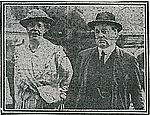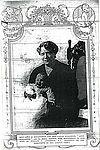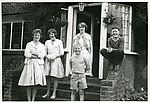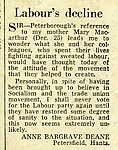 Mary and her husband, William Anderson
Mary and her husband, William Anderson Mary and daughter Nancy
Mary and daughter Nancy Mary's daughter Nancy (Aged 5)
Mary's daughter Nancy (Aged 5) Nancy's three children and their cousins (1960s)
Nancy's three children and their cousins (1960s) Nancy's letter to the editor (1970)
Nancy's letter to the editor (1970)

Mary's work was so important to her, that she delayed marrying Will Anderson until 1911. Their marriage was a very happy one, but tragically short. Will died in 1919. Mary never fully recovered from the loss. She died in 1921 at the age of 40. They had one daughter, Nancy, born 1915.
Will Anderson had known Mary for a long time. They met at a union meeting in Ayr when they were in their twenties. They found that they shared the same socialist values, and a determination to improve conditions for working people.
In 1903, Will asked Mary to marry him, but she refused. She was just 23 and felt that her work had to come first. In her biography of Mary, M.A. Hamilton said he was not discouraged. "A Banffshire Scot, with a double dose of reticence and caution, he had found his centre, and cared too deeply to let go."
Will wrote to Mary, "If you have fully and deeply persuaded yourself as to your future, I shall not meantime try to shake your resolution. I think you may easily go wrong, but you will go wrong trying to do right....It is rank heresy, I know, but one is privileged in one's last letter, and I suggest that Miss Macarthur has not yet been attuned to her deepest and sweetest music, that she is not yet, wonderful woman that she is, so rounded and complete as she will be, and that she has capacities which have hardly yet been stirred."
Mary's work by this time had taken her to London, Will's work was in Glasgow. His work as an organiser for the Shop Assistants' Union sometimes took him to London, but when he left trade unionism for politics he was based there permanently, and was able to keep in closer contact with Mary. He helped her with "The Woman Worker", a penny newspaper launched and initially edited by Mary. It was the official publication of the newly formed National Federation of Women Workers (N.F.W.W.), which described itself as, "the only woman's paper which assumes that its readers are not dolls or drudges, but WOMEN."
Will's wait finally came to an end when Mary agreed to marry him. The wedding took place on 21st September 1911 at City Temple. It was presided over by the Reverend Campbell. Mary's father was present, and amongst the guests were Margaret Bondfield, Gertrude Tuckwell and J.J.Mallon. The couple left for a ten day honeymoon in Paris and Brussells. When they returned, Mary went through a general election battle at his side, speaking at many meetings on his behalf. In 1912 the couple moved into 27, Mecklenburgh Square. They shared their living quarters with the Insurance Department of the N.F.W.W. Mary reasoned that by living there she could save time during the working day.
Will turned out to be perfect for her, as he put her career first, believing she possessed greater powers for good than his own. Mary often said, "How much is he too good for me?" Her gave her the emotional steadiness and kindly serenity, which her whirlwind temperament needed.
Tragedy struck in 1913, when Mary gave birth to a stillborn baby boy. She did not speak publicly for several months after, the wound healing only on the birth of a daughter in 1915. Known as Nancy, she was named Elizabeth Anne after Mary's mother. At the time they lived in an old Georgian house in Caroline Place, Bloomsbury. A visitor to the house, when Nancy was just five months old, wrote of her, "she clenches and raises a fiery fist, for all the world as though she were going to develop into another orator, which would hardly be unnatural considering her parentage."
There were many visitors to the Andersons' home, including union and political leaders. They had moved to 7, Mecklenburgh Square to escape the hustle and bustle of trade union offices. Arthur Henderson, Labour M.P. and Chief Whip of the Labour Party at the time of his visit, recalled a happy occasion of domesticity. "I was at their home in the Square, and we talked over everything that mattered, to us at least. We were having some fun with the little girl, and in the midst of a most enjoyable romp, the whole house went dark, and we all three said at once, 'That's the electrical strike on!' We had been talking just a few minutes before about the threat of cutting off the electrical supply of London, and we thought the time had come. Mary got some matches and began to hunt for a candle, but the real cause was discovered - a fuse had blown and cut off the house supply. The matter was put right and the fun continued." (The Labour Woman, February 1921)
In 1919 Will caught influenza, which turned to pneumonia. He died on the morning of 25th February. Mary never really recovered from his loss. She continued with her work, but it brought her little solace. She visited America in April 1919, and again in October the same year, as adviser to the British Workers' delegation at the first conference of the International Labour Organisation.
On her return she moved with Nancy and Susan Lawrence to Golders Green. The following year, after attending the Labour Party conference in Scarborough, she travelled to Geneva with Susan Lawrence and Madeleine Symons to take part in a conference of the Second International. In 1920 she was made a J.P. in Hendon, but by this time her health was failing. She underwent two operations for cancer, but they were unsuccessful. She died at her home on 1st January 1921.
Nancy was brought up by an aunt until she was twelve, when she went to Bedales School, as her mother had stipulated. She had followed the advice of Ramsay MacDonald, who had a very high opinion of the school's founder, J.H. Badley. From the age of eighteen, Nancy lived in London with Susan Lawrence and spent some time with her guardian, Madeleine Symons. In 1939 she married a naval officer, I.H. Bargrave Deane.
The photograph shows Nancy's three children, Sally, Juliet and James, (Mary's grandchildren), in the 1960s. The young woman on the far left, Margaret, and the boy standing in front, David, are their cousins, the grandchildren of Jean, Mary's sister.
The newspaper cutting shows a letter written by Nancy in the 1970s. She writes with pride of her mother's achievements, and it seems from the tone of the letter that she inherited some of her spirit.
Rollover the captions in the box to see the available images in thumbnail format, click the caption to see the full-size image
| Reference: | 644 |
| Keywords: | |
| Archive Ref: | |
| Updated: | Fri 27 Apr 2007 - 0 |
| Interpretation written by | Barbara Harris |
| Author's organisation | |
| Organisation's website |